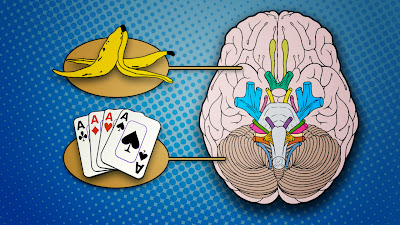 |
| Brain Is Playing Tricks. |
The Right Brain Left Brain Theory
The right brain left brain dominance theory goes something like this: each side of the brain controls different types of thinking and people usually prefer one to the other.
If you're left brain dominant, your style of thinking is logical, focused, and analytical. You tend to think in a linear fashion.
If you're right brain dominant, you're intuitive, holistic, and creative. You tend to think in a nonlinear fashion.
Both sides or modes of thinking are equally important and when combined can be powerful. The truth is, the brain is much more complicated than this and works in a more interconnected way. However, this theory is still a great way to refer to the two modes of thinking because it's so widely known and the labels are now synonymous with linear and nonlinear styles of thinking. It's a simple and effective way to refer to and visualize how we use our brains.
Why Creativity is Crucial
How we use our brains is not only crucial to our survival, it also determines whether we succeed or fail. Our world is changing at a rapid rate and this makes it necessary to be able to think in a nonlinear fashion as well as a linear fashion.
We need use our right brains to get the "big picture," and generate creative ideas and novel approaches to think strategically. We have to improve our brain power. On that note, let's take a look at how our "left brain" tricks us into thinking we aren't creative.
5 Tricks Your Left Brain Plays on You
Here are five sneaky ways your left brain tricks you. Once you know what they are, you'll have a much better chance at avoiding them.
Limited View
The view from inside the left brain linear approach is limiting. Think of a straight line (the line represents your thinking). You start at a specific point (the points represent your ideas) and you build step by step on that point. This way of thinking is organized, controlled, and works well in specific situations, albeit limiting. Now think of a circle (the circle represents your mode of thinking) with many random points (the points represent ideas) inside that circle that can be connected in novel ways. Not as logical—but many more unique connections. If you picture nonlinear in terms of a circle you can see that it opens up the possibility of unlimited creative ideas. This type of thinking is crucial in an environment that is changing rapidly.
Linear = Safe
We tend to feel a certain amount of control and safety in a tried and true structure. In this case, left brain thinking provides that organized structure. We go from one step to the next. We are very focused. The outcome is fairly predictable. It's a safe approach. The problem is that it's not safe to be stuck in this mode of thinking. Quite the contrary, it appears nonlinear thinking is becoming safer in terms of survival and being able to succeed in today's world. Thinking outside paradigms and thinking in creative ways is proving to be a powerful skill to have.
Logic
Logic is powerful. However, when we step outside of logic we can utilize the power of intuition. Intuition pulls its information from seemingly invisible sources that we can't point to but that we are in tune with. When you think in a nonlinear creative fashion, intuition is your guide.
Part to Whole
Putting parts together to get a whole is necessary for building things. You take pieces, line them up, make a whole, and then draw conclusions. However, sometimes it is more advantageous to look at the whole first and break it down into parts. Right brain thinking looks at the whole first. In this ever-changing world we need to get the "big picture" view first in order to maneuver life.
You're Not Creative
The left brain tricks you into thinking you're not creative and can't generate new ideas. When we get used to something, we get stuck in a pattern. This makes it difficult to break out of a limited mode of thinking. In this case, you may identify with being logical and analytical and may be disconnected from your creative right brain.

0 comments:
Post a Comment